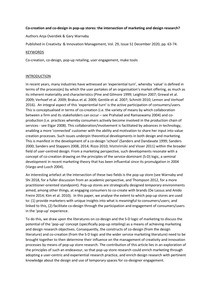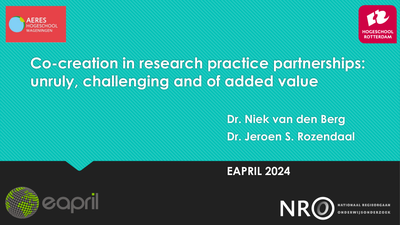Co-creation as a concept and process has been prominent in both marketing and design research over the past ten years. Referring respectively to the active collaboration of firms with their stakeholders in value creation, or to the participation of design users in the design research process, there has arguably been little common discourse between these academic disciplines. This article seeks to redress this deficiency by connecting marketing and design research together—and particularly the concepts of co-creation and co-design—to advance theory and broaden the scope of applied research into the topic. It does this by elaborating the notion of the pop-up store as temporary place of consumer/user engagement, to build common ground for theory and experimentation in terms of allowing marketers insight into what is meaningful to consumers and in terms of facilitating co-design. The article describes two case studies, which outline how this can occur and concludes by proposing principles and an agenda for future marketing/design pop-up research. This is the peer reviewed version of the following article: Overdiek A. & Warnaby G. (2020), "Co-creation and co-design in pop-up stores: the intersection of marketing and design research?", Creativity & Innovation Management, Vol. 29, Issue S1, pp. 63-74, which has been published in final form at https://doi.org/10.1111/caim.12373. This article may be used for non-commercial purposes in accordance with Wiley Terms and Conditions for Use of Self-Archived Versions. LinkedIn: https://nl.linkedin.com/in/overdiek12345
MULTIFILE

Social innovation and co-creation have been discussed in academic literature for the last twenty years. However, the interrelatedness and application of these concepts in European Union policy deserves more attention. In our study, we focus on this relationship and application, by analysing the value of co-creation for social innovation. By analysing a large EU dataset, we showed that social innovation and co-creation were used more and more widely and that their use took off after 2010 and 2015 respectively. By applying a contextual analysis, we also revealed that both concepts became connected in EU policy on research and innovation. Our analysis also shows that co-creation became an indicator for successful social innovation in the Horizon Europe Framework programme. These results show the importance of co-creation in policies, but because the concept has not been defined properly, this carries the risk of simplifying co-creation into a box-ticking exercise.
DOCUMENT
Co-creation and social innovation are currently linked concepts in both policy and academic research. Almost always, the attitude towards these concepts is intrinsically positive, although evidence of their added value is lacking. In my research, I looked at the development of social innovation and co-creation in theory and practice. By analysing the use of these notions in EU policies, EU grants and awarded EU projects, I was able to show that both concepts are not only unclear, but are also mutually strengthen and add value to each other. For example, co-creation is seen as an integral part of social innovation and therefore stakeholder involvement is sufficient to qualify as good social innovation, without further evidence. A systematic literature review supports these findings.Because of the ambiguity of both concepts and the fact that they reinforce each other, there is hardly any attention to the quality of co-creation as such within social innovation. We witness this not only in social innovation projects, but also, for example, in so-called living labs. In order to monitor and improve the quality of co-creation within social innovation, an evaluation framework was developed based on a systematic literature review. This framework can be used by both policy makers and participants in social innovation projects.
DOCUMENT

This article is based on five years of longitudinal participatory action research on how former pre‐bachelor programme students with a refugee background experience finding their way into Dutch higher education and society. The four‐member research team and authors (two of which were former refugees), found that refugee students face a significant barrier of “us‐versus‐them,” especially in an educational context. We explored how creative co‐creation contributed to rethinking difference and sameness in higher education by breaking through or transcending this divide. Creative co‐creation through play, storytelling, or constructing artefacts enables “alterity,” approaching the other from the other’s position. Movement and action help to shape the world around us: Connecting and shifting positions creates sameness while leaving space for difference. Creative co‐creation during our research process included making co‐creation artefacts and activities, thus involving outreach to broader audiences for engagement. In the research process, it became clear that successful participation matters to all students and provides more opportunities for all, not just refugee students. A new notion of “we” in Dutch higher education and society that does not perpetuate the divide between “us” and “them” requires a shared responsibility. Higher education needs the university authorities and the teachers to make room for student stories and should provide spaces for dialogue and community development.
LINK
Active participation of stakeholders in health research practice is important to generate societal impact of outcomes, as innovations will more likely be implemented and disseminated in clinical practice. To foster a co-creative process, numerous frameworks and tools are available. As they originate from different professions, it is not evident that health researchers are aware of these tools, or able to select and use them in a meaningful way. This article describes the bottom-up development process of a compass and presents the final outcome. This Co-creation Impact Compass combines a well-known business model with tools from design thinking that promote active participation by all relevant stakeholders. It aims to support healthcare researchers to select helpful and valid co-creation tools for the right purpose and at the right moment. Using the Co-creation Impact Compass might increase the researchers’ understanding of the value of co-creation, and it provides help to engage stakeholders in all phases of a research project.
DOCUMENT

This paper analyses co-creation in urban living labs through a multi-level network perspective on system innovation. We draw on the case House of Skills, a large, multi-stakeholder living lab aimed at developing a ‘skills-based’ approach towards labour market innovation within the Amsterdam Metropolitan Region. Ouranalysis helps understand stakeholder dynamics towards system innovation, drawing on an innovative living lab example and taking into consideration the multi-layered structures that comprise the collaboration. Our conceptual framework provides an important theoretical contribution to innovation studies and offers a practical repertoire that can help practitioners improve co-creation of shared value in living labs, towards orchestrating flexible structures that strengthen the impact of their initiatives.
LINK
Immersive technologies are redefining and revolutionizing the staging of experiences and co-creation of value, implicating the management of customer experiences. However, limited studies have looked at the role of immersive technologies as part of the customer experience management (CXM) process. Incorporating the concepts of experience economy and value co-creation, this study proposes a dynamic CXM framework that highlights the emerging field of immersive technologies like augmented and virtual reality as part of business and marketing research. The framework acts as a guide for researchers and industry practitioners to initiate immersive technology ventures that are rooted in the co-creation and management of customer experiences
MULTIFILE
In the Enabling step it is time to make the dream come true! In order to realize the dream, the diverse stakeholders must be able to interact with one another and have the opportunity to co-create. Platforms, whether live or virtual, facilitate and enable this interaction. They define the general rules of engagement and make data available to the stakeholders. Imagineering calls for this all to be done in a very practical way so as to enable value creation by inspiring collective creativity. You will find definitions and criteria in this chapter that are illustrated with examples. In addition, the concept of co-creation is explained. The building blocks are introduced by looking at the why and the what of the platform. We explain how to build an inspiring platform for a complex system. The chapter ends with a reminder that designing a platform is a never-ending story of curiosity, flexibility, experimentation and reflection.
LINK
More than 25!years after Moore’s first introduction of the public value concept in 995, the concept is now widely used, but its operationalization is still considered difficult. This paper presents the empirical results of a study analyzing the application of the public value concept in Higher Education Institutions, thereby focusing on how to account for public value. The paper shows how Dutch universities of applied sciences operationalize the concept ‘public value’, and how they report on the outcome achievements. The official strategy plans and annual reports for FY2016 through FY2018 of the ten largest institutions were used. While we find that all the institutions selected aim to deliver public value, they still use performance indicators that have a more narrow orientation, and are primarily focused on processes, outputs, and service delivery quality. However, we also observe that they use narratives to show the public value they created. In this way this paper contributes to the literature on public value accounting.
DOCUMENT

Workshop EAPRIL Conference, November 26 - 28, Hasselt
DOCUMENT
